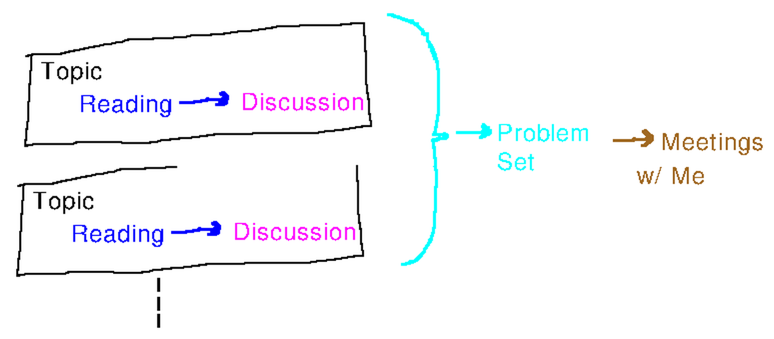Welcome to Doug Baldwin’s Math 221!
Questions?
In other words, is there anything you particularly want to talk about?
(There wasn’t.)
Some Course Policies and Practices
Supplemental Instruction
A system of near-peer tutoring, where a student who has recently done well in this course runs optional review/problem-solving/etc. meetings.
See this morning’s Canvas announcement from our SI leader Emiliana introducing herself.
The Course’s Rhythm
I’ve divided the content of this course into “topics,” i.e., self-contained units that will take on the order of 2-ish (maybe 1, maybe more than 2, but most likely 2) class days to cover.
In each topic, I’ll start by asking you to do some reading to get the basic ideas.
Then there will be a mixture of online and in-class discussion, often based on solving some example problems, to start you using the ideas and to bring out any questions about them.
A couple of topics will form the basis for a problem set (there will be roughly 1 problem set per week).
Problem sets are the main (but not the only) topic of conversation for your weekly individual meetings with me.

The schedule of class meetings more or less sets the pace for covering topics, but everyone should do all of the online work, regardless of whether your cohort comes to the class most closely aligned with it.
Weekly individual meetings start next week. The easiest way to set them up is through Google calendar. I did a quick demo of one way to do this, and this video from CIT walks you through another:
Mastery Grading and Equity
Mastery grading = grading based on achieving course outcomes only.
Some implications of that word “only”:
- There will be no use of “grades as currency,” i.e., grades as a way of “paying” you to do things I want (for instance, extra credit for out-of-class projects) or “fining” you for things I don’t want (e.g., grade penalties for turning things in late).
- To a limited extent, you can redo outcomes within problem sets if you want a bit more practice to understand them better; your grade is less subject to how you performed at the time and place of a single (or a few) high-stakes test(s). You can have up to 1 redo per outcome per problem set.
Each problem set is associated with one or more course learning outcomes (see the list of them in the syllabus), and will be graded for each of those outcomes against the rubric in the syllabus. So you might get 2 or 3 grades for a single problem set, depending on how many outcomes it touches.
Your overall grade for each outcome will be the average of your 2 highest grades for that outcome, and your most recent.
Notice that course grades come from problem set grades via “distributed oral exams,” i.e, a scary term for those weekly meetings you have with me (but hopefully it won’t be scary in practice). Expect to not only show me your solutions in those meetings, but also to tell me a little about how and why you solved the problems the way you did, and to answer questions about that process.
Next
In other words, what are we doing around Wednesday’s meeting, even though you won’t be at it.
There’s still a fair bit from the syllabus that I want to be sure you’re comfortable with, so we’ll keep discussing it between now and Wednesday.
Continue today’s discussion and set a foundation for Wednesday’s by contributing to this online discussion in Canvas between now and class time Wednesday.